CX660014 Project Management: Literature Review and Analysis
VerifiedAdded on 2022/12/27
|13
|3567
|95
Report
AI Summary
This document presents a comprehensive literature review focused on project management principles, tools, and techniques. It begins with an exploration of the project charter, delving into its significance as a formal document that outlines project details, stakeholders, and their roles. The review then examines project plans, emphasizing their role in guiding project execution and ensuring stakeholder approval. Project scope, including goals, deliverables, and activities, is discussed, along with the importance of effective scope management. Risk management, including risk identification, mitigation strategies, and communication, is analyzed. Project deliverables, WBS, Gantt charts, network diagrams, and project budgeting are also examined to showcase the project management tools. The review highlights the importance of each component in successful project management, including roles and responsibilities, and project approval processes. The assignment covers key project management terminology and concepts, including project phases, constraints, and the role of project managers. The document includes references to academic sources that support the information provided.

Running head: LITERATURE REVIEW
Part 1: Literature review
Name of the Student
Name of the University
Author’s Note
Part 1: Literature review
Name of the Student
Name of the University
Author’s Note
Paraphrase This Document
Need a fresh take? Get an instant paraphrase of this document with our AI Paraphraser
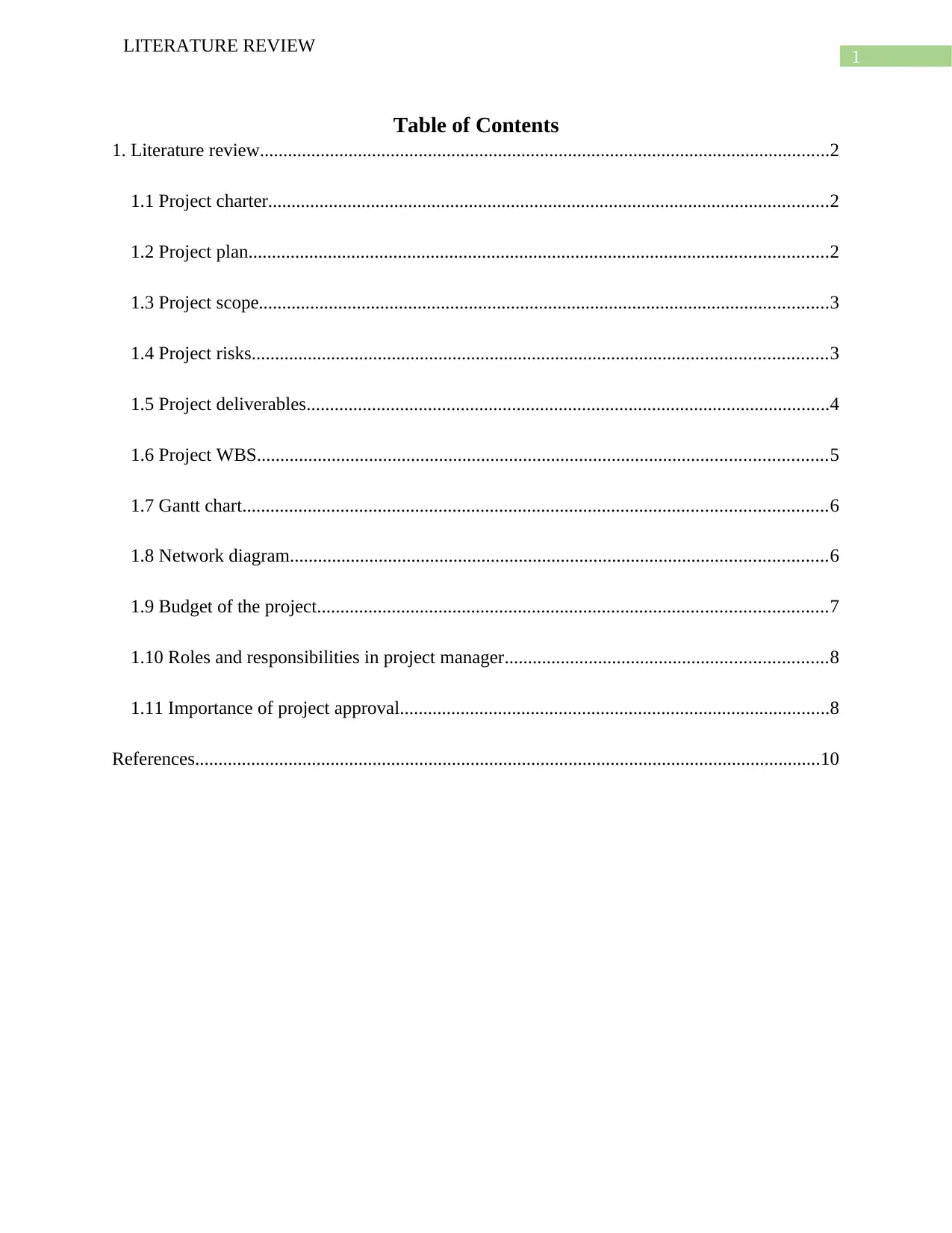
1
LITERATURE REVIEW
Table of Contents
1. Literature review..........................................................................................................................2
1.1 Project charter........................................................................................................................2
1.2 Project plan............................................................................................................................2
1.3 Project scope..........................................................................................................................3
1.4 Project risks...........................................................................................................................3
1.5 Project deliverables................................................................................................................4
1.6 Project WBS..........................................................................................................................5
1.7 Gantt chart.............................................................................................................................6
1.8 Network diagram...................................................................................................................6
1.9 Budget of the project.............................................................................................................7
1.10 Roles and responsibilities in project manager.....................................................................8
1.11 Importance of project approval............................................................................................8
References......................................................................................................................................10
LITERATURE REVIEW
Table of Contents
1. Literature review..........................................................................................................................2
1.1 Project charter........................................................................................................................2
1.2 Project plan............................................................................................................................2
1.3 Project scope..........................................................................................................................3
1.4 Project risks...........................................................................................................................3
1.5 Project deliverables................................................................................................................4
1.6 Project WBS..........................................................................................................................5
1.7 Gantt chart.............................................................................................................................6
1.8 Network diagram...................................................................................................................6
1.9 Budget of the project.............................................................................................................7
1.10 Roles and responsibilities in project manager.....................................................................8
1.11 Importance of project approval............................................................................................8
References......................................................................................................................................10
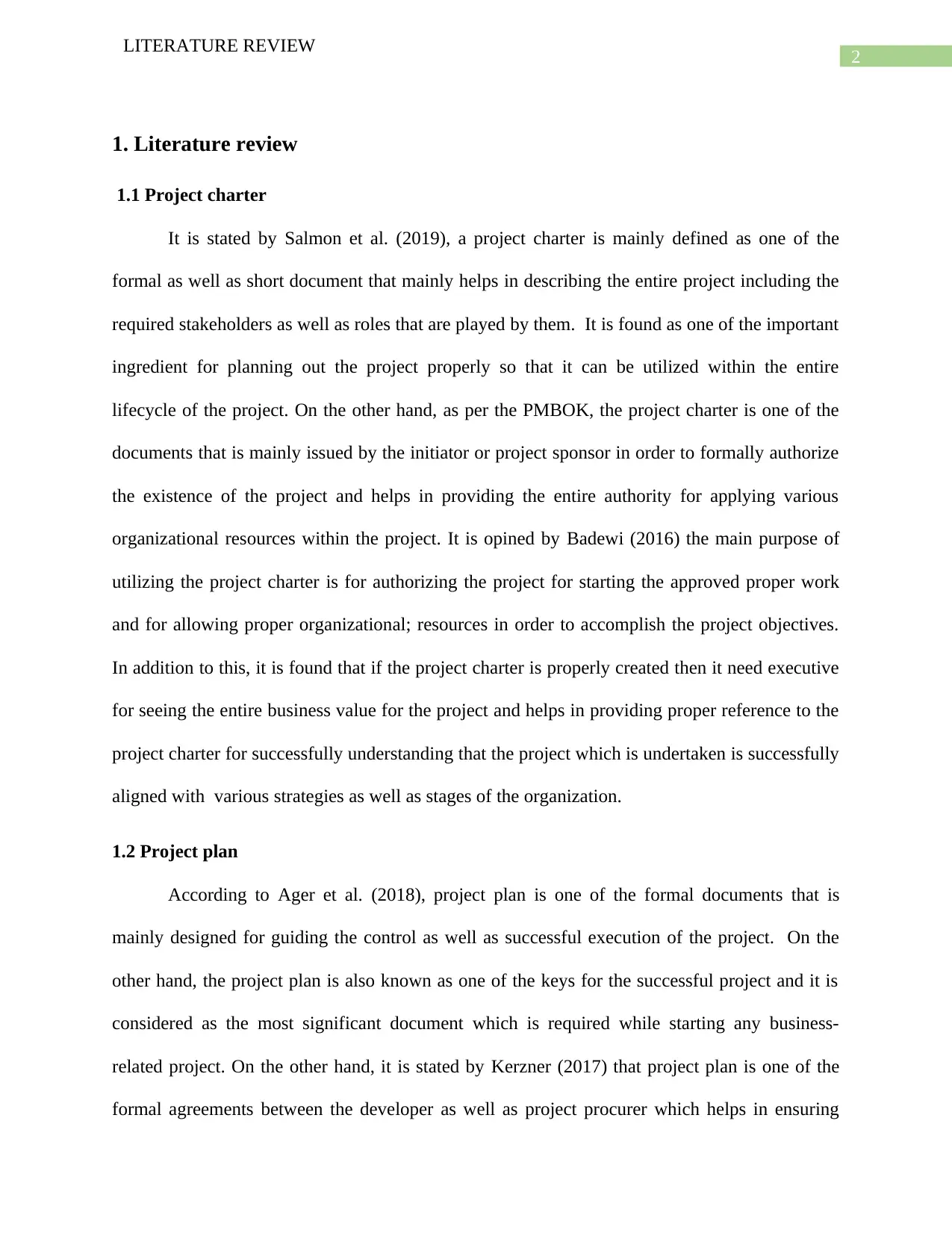
2
LITERATURE REVIEW
1. Literature review
1.1 Project charter
It is stated by Salmon et al. (2019), a project charter is mainly defined as one of the
formal as well as short document that mainly helps in describing the entire project including the
required stakeholders as well as roles that are played by them. It is found as one of the important
ingredient for planning out the project properly so that it can be utilized within the entire
lifecycle of the project. On the other hand, as per the PMBOK, the project charter is one of the
documents that is mainly issued by the initiator or project sponsor in order to formally authorize
the existence of the project and helps in providing the entire authority for applying various
organizational resources within the project. It is opined by Badewi (2016) the main purpose of
utilizing the project charter is for authorizing the project for starting the approved proper work
and for allowing proper organizational; resources in order to accomplish the project objectives.
In addition to this, it is found that if the project charter is properly created then it need executive
for seeing the entire business value for the project and helps in providing proper reference to the
project charter for successfully understanding that the project which is undertaken is successfully
aligned with various strategies as well as stages of the organization.
1.2 Project plan
According to Ager et al. (2018), project plan is one of the formal documents that is
mainly designed for guiding the control as well as successful execution of the project. On the
other hand, the project plan is also known as one of the keys for the successful project and it is
considered as the most significant document which is required while starting any business-
related project. On the other hand, it is stated by Kerzner (2017) that project plan is one of the
formal agreements between the developer as well as project procurer which helps in ensuring
LITERATURE REVIEW
1. Literature review
1.1 Project charter
It is stated by Salmon et al. (2019), a project charter is mainly defined as one of the
formal as well as short document that mainly helps in describing the entire project including the
required stakeholders as well as roles that are played by them. It is found as one of the important
ingredient for planning out the project properly so that it can be utilized within the entire
lifecycle of the project. On the other hand, as per the PMBOK, the project charter is one of the
documents that is mainly issued by the initiator or project sponsor in order to formally authorize
the existence of the project and helps in providing the entire authority for applying various
organizational resources within the project. It is opined by Badewi (2016) the main purpose of
utilizing the project charter is for authorizing the project for starting the approved proper work
and for allowing proper organizational; resources in order to accomplish the project objectives.
In addition to this, it is found that if the project charter is properly created then it need executive
for seeing the entire business value for the project and helps in providing proper reference to the
project charter for successfully understanding that the project which is undertaken is successfully
aligned with various strategies as well as stages of the organization.
1.2 Project plan
According to Ager et al. (2018), project plan is one of the formal documents that is
mainly designed for guiding the control as well as successful execution of the project. On the
other hand, the project plan is also known as one of the keys for the successful project and it is
considered as the most significant document which is required while starting any business-
related project. On the other hand, it is stated by Kerzner (2017) that project plan is one of the
formal agreements between the developer as well as project procurer which helps in ensuring
⊘ This is a preview!⊘
Do you want full access?
Subscribe today to unlock all pages.

Trusted by 1+ million students worldwide
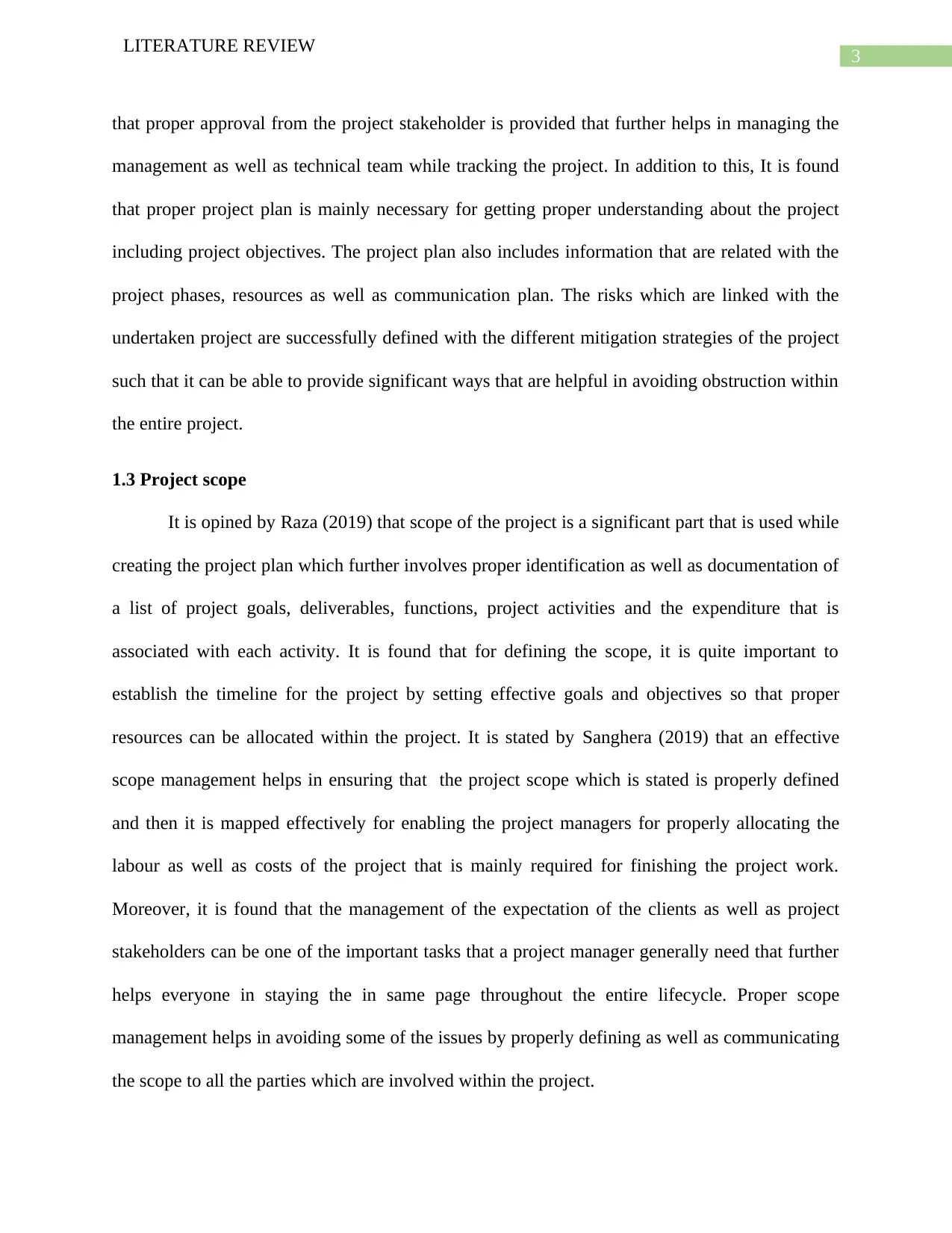
3
LITERATURE REVIEW
that proper approval from the project stakeholder is provided that further helps in managing the
management as well as technical team while tracking the project. In addition to this, It is found
that proper project plan is mainly necessary for getting proper understanding about the project
including project objectives. The project plan also includes information that are related with the
project phases, resources as well as communication plan. The risks which are linked with the
undertaken project are successfully defined with the different mitigation strategies of the project
such that it can be able to provide significant ways that are helpful in avoiding obstruction within
the entire project.
1.3 Project scope
It is opined by Raza (2019) that scope of the project is a significant part that is used while
creating the project plan which further involves proper identification as well as documentation of
a list of project goals, deliverables, functions, project activities and the expenditure that is
associated with each activity. It is found that for defining the scope, it is quite important to
establish the timeline for the project by setting effective goals and objectives so that proper
resources can be allocated within the project. It is stated by Sanghera (2019) that an effective
scope management helps in ensuring that the project scope which is stated is properly defined
and then it is mapped effectively for enabling the project managers for properly allocating the
labour as well as costs of the project that is mainly required for finishing the project work.
Moreover, it is found that the management of the expectation of the clients as well as project
stakeholders can be one of the important tasks that a project manager generally need that further
helps everyone in staying the in same page throughout the entire lifecycle. Proper scope
management helps in avoiding some of the issues by properly defining as well as communicating
the scope to all the parties which are involved within the project.
LITERATURE REVIEW
that proper approval from the project stakeholder is provided that further helps in managing the
management as well as technical team while tracking the project. In addition to this, It is found
that proper project plan is mainly necessary for getting proper understanding about the project
including project objectives. The project plan also includes information that are related with the
project phases, resources as well as communication plan. The risks which are linked with the
undertaken project are successfully defined with the different mitigation strategies of the project
such that it can be able to provide significant ways that are helpful in avoiding obstruction within
the entire project.
1.3 Project scope
It is opined by Raza (2019) that scope of the project is a significant part that is used while
creating the project plan which further involves proper identification as well as documentation of
a list of project goals, deliverables, functions, project activities and the expenditure that is
associated with each activity. It is found that for defining the scope, it is quite important to
establish the timeline for the project by setting effective goals and objectives so that proper
resources can be allocated within the project. It is stated by Sanghera (2019) that an effective
scope management helps in ensuring that the project scope which is stated is properly defined
and then it is mapped effectively for enabling the project managers for properly allocating the
labour as well as costs of the project that is mainly required for finishing the project work.
Moreover, it is found that the management of the expectation of the clients as well as project
stakeholders can be one of the important tasks that a project manager generally need that further
helps everyone in staying the in same page throughout the entire lifecycle. Proper scope
management helps in avoiding some of the issues by properly defining as well as communicating
the scope to all the parties which are involved within the project.
Paraphrase This Document
Need a fresh take? Get an instant paraphrase of this document with our AI Paraphraser
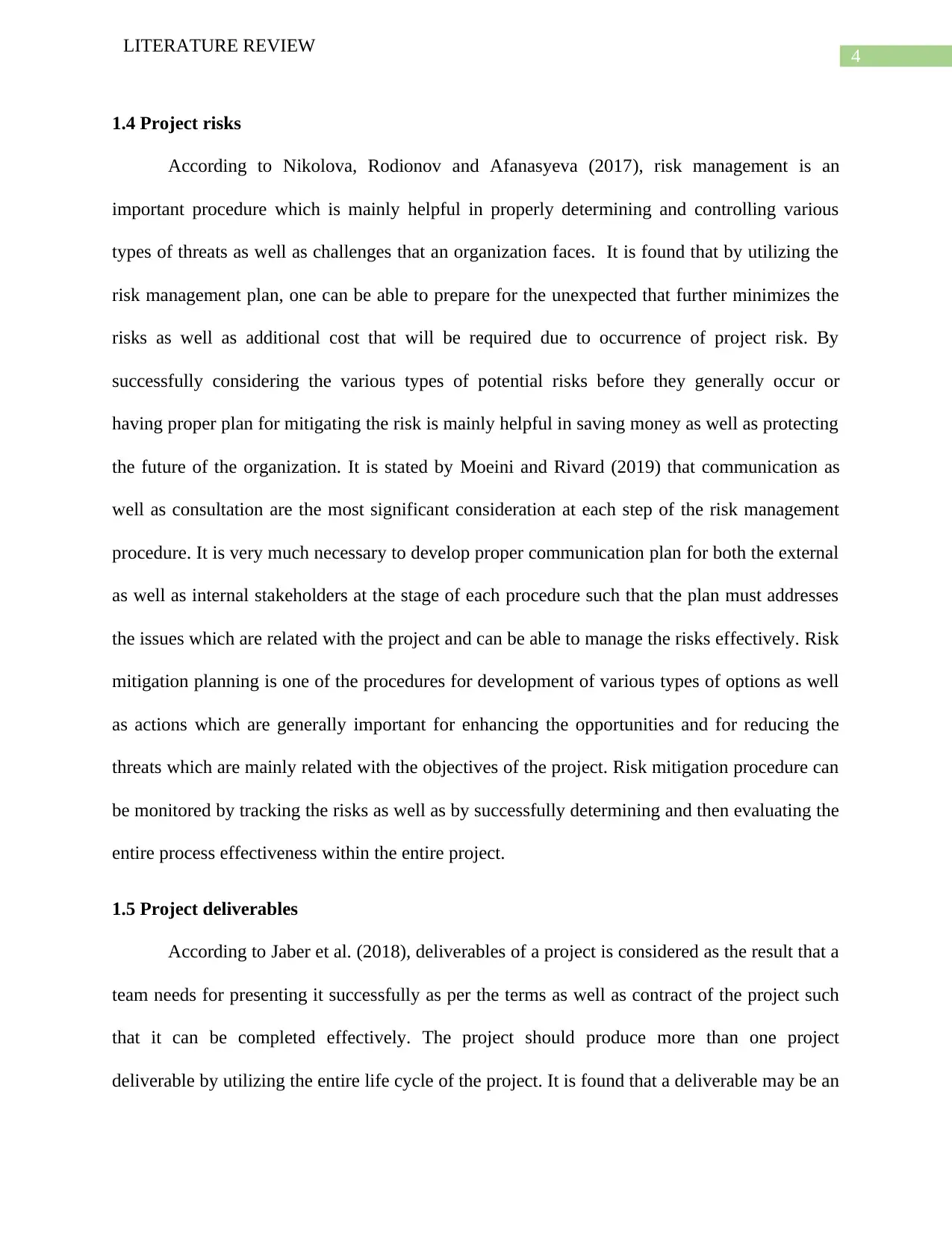
4
LITERATURE REVIEW
1.4 Project risks
According to Nikolova, Rodionov and Afanasyeva (2017), risk management is an
important procedure which is mainly helpful in properly determining and controlling various
types of threats as well as challenges that an organization faces. It is found that by utilizing the
risk management plan, one can be able to prepare for the unexpected that further minimizes the
risks as well as additional cost that will be required due to occurrence of project risk. By
successfully considering the various types of potential risks before they generally occur or
having proper plan for mitigating the risk is mainly helpful in saving money as well as protecting
the future of the organization. It is stated by Moeini and Rivard (2019) that communication as
well as consultation are the most significant consideration at each step of the risk management
procedure. It is very much necessary to develop proper communication plan for both the external
as well as internal stakeholders at the stage of each procedure such that the plan must addresses
the issues which are related with the project and can be able to manage the risks effectively. Risk
mitigation planning is one of the procedures for development of various types of options as well
as actions which are generally important for enhancing the opportunities and for reducing the
threats which are mainly related with the objectives of the project. Risk mitigation procedure can
be monitored by tracking the risks as well as by successfully determining and then evaluating the
entire process effectiveness within the entire project.
1.5 Project deliverables
According to Jaber et al. (2018), deliverables of a project is considered as the result that a
team needs for presenting it successfully as per the terms as well as contract of the project such
that it can be completed effectively. The project should produce more than one project
deliverable by utilizing the entire life cycle of the project. It is found that a deliverable may be an
LITERATURE REVIEW
1.4 Project risks
According to Nikolova, Rodionov and Afanasyeva (2017), risk management is an
important procedure which is mainly helpful in properly determining and controlling various
types of threats as well as challenges that an organization faces. It is found that by utilizing the
risk management plan, one can be able to prepare for the unexpected that further minimizes the
risks as well as additional cost that will be required due to occurrence of project risk. By
successfully considering the various types of potential risks before they generally occur or
having proper plan for mitigating the risk is mainly helpful in saving money as well as protecting
the future of the organization. It is stated by Moeini and Rivard (2019) that communication as
well as consultation are the most significant consideration at each step of the risk management
procedure. It is very much necessary to develop proper communication plan for both the external
as well as internal stakeholders at the stage of each procedure such that the plan must addresses
the issues which are related with the project and can be able to manage the risks effectively. Risk
mitigation planning is one of the procedures for development of various types of options as well
as actions which are generally important for enhancing the opportunities and for reducing the
threats which are mainly related with the objectives of the project. Risk mitigation procedure can
be monitored by tracking the risks as well as by successfully determining and then evaluating the
entire process effectiveness within the entire project.
1.5 Project deliverables
According to Jaber et al. (2018), deliverables of a project is considered as the result that a
team needs for presenting it successfully as per the terms as well as contract of the project such
that it can be completed effectively. The project should produce more than one project
deliverable by utilizing the entire life cycle of the project. It is found that a deliverable may be an
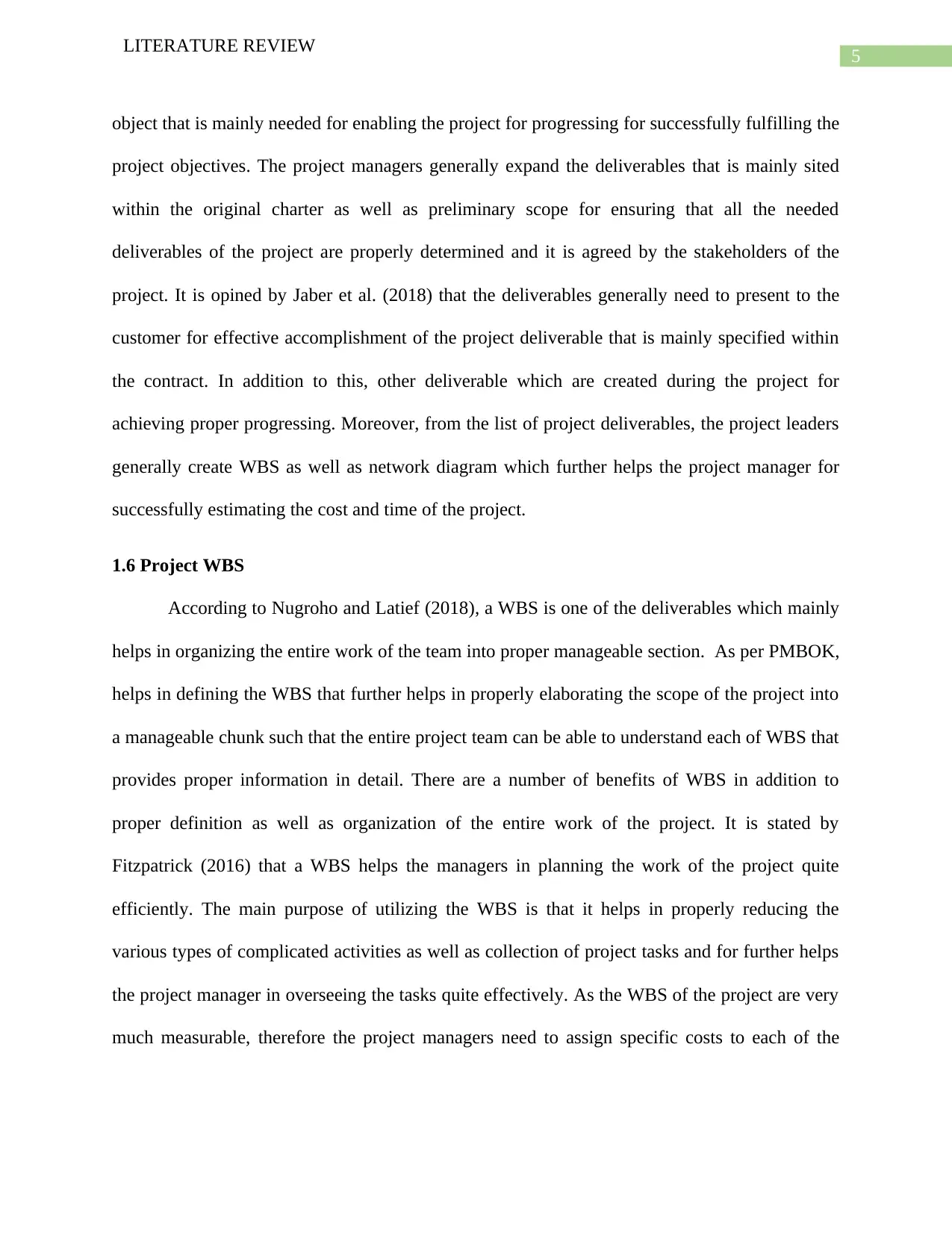
5
LITERATURE REVIEW
object that is mainly needed for enabling the project for progressing for successfully fulfilling the
project objectives. The project managers generally expand the deliverables that is mainly sited
within the original charter as well as preliminary scope for ensuring that all the needed
deliverables of the project are properly determined and it is agreed by the stakeholders of the
project. It is opined by Jaber et al. (2018) that the deliverables generally need to present to the
customer for effective accomplishment of the project deliverable that is mainly specified within
the contract. In addition to this, other deliverable which are created during the project for
achieving proper progressing. Moreover, from the list of project deliverables, the project leaders
generally create WBS as well as network diagram which further helps the project manager for
successfully estimating the cost and time of the project.
1.6 Project WBS
According to Nugroho and Latief (2018), a WBS is one of the deliverables which mainly
helps in organizing the entire work of the team into proper manageable section. As per PMBOK,
helps in defining the WBS that further helps in properly elaborating the scope of the project into
a manageable chunk such that the entire project team can be able to understand each of WBS that
provides proper information in detail. There are a number of benefits of WBS in addition to
proper definition as well as organization of the entire work of the project. It is stated by
Fitzpatrick (2016) that a WBS helps the managers in planning the work of the project quite
efficiently. The main purpose of utilizing the WBS is that it helps in properly reducing the
various types of complicated activities as well as collection of project tasks and for further helps
the project manager in overseeing the tasks quite effectively. As the WBS of the project are very
much measurable, therefore the project managers need to assign specific costs to each of the
LITERATURE REVIEW
object that is mainly needed for enabling the project for progressing for successfully fulfilling the
project objectives. The project managers generally expand the deliverables that is mainly sited
within the original charter as well as preliminary scope for ensuring that all the needed
deliverables of the project are properly determined and it is agreed by the stakeholders of the
project. It is opined by Jaber et al. (2018) that the deliverables generally need to present to the
customer for effective accomplishment of the project deliverable that is mainly specified within
the contract. In addition to this, other deliverable which are created during the project for
achieving proper progressing. Moreover, from the list of project deliverables, the project leaders
generally create WBS as well as network diagram which further helps the project manager for
successfully estimating the cost and time of the project.
1.6 Project WBS
According to Nugroho and Latief (2018), a WBS is one of the deliverables which mainly
helps in organizing the entire work of the team into proper manageable section. As per PMBOK,
helps in defining the WBS that further helps in properly elaborating the scope of the project into
a manageable chunk such that the entire project team can be able to understand each of WBS that
provides proper information in detail. There are a number of benefits of WBS in addition to
proper definition as well as organization of the entire work of the project. It is stated by
Fitzpatrick (2016) that a WBS helps the managers in planning the work of the project quite
efficiently. The main purpose of utilizing the WBS is that it helps in properly reducing the
various types of complicated activities as well as collection of project tasks and for further helps
the project manager in overseeing the tasks quite effectively. As the WBS of the project are very
much measurable, therefore the project managers need to assign specific costs to each of the
⊘ This is a preview!⊘
Do you want full access?
Subscribe today to unlock all pages.

Trusted by 1+ million students worldwide
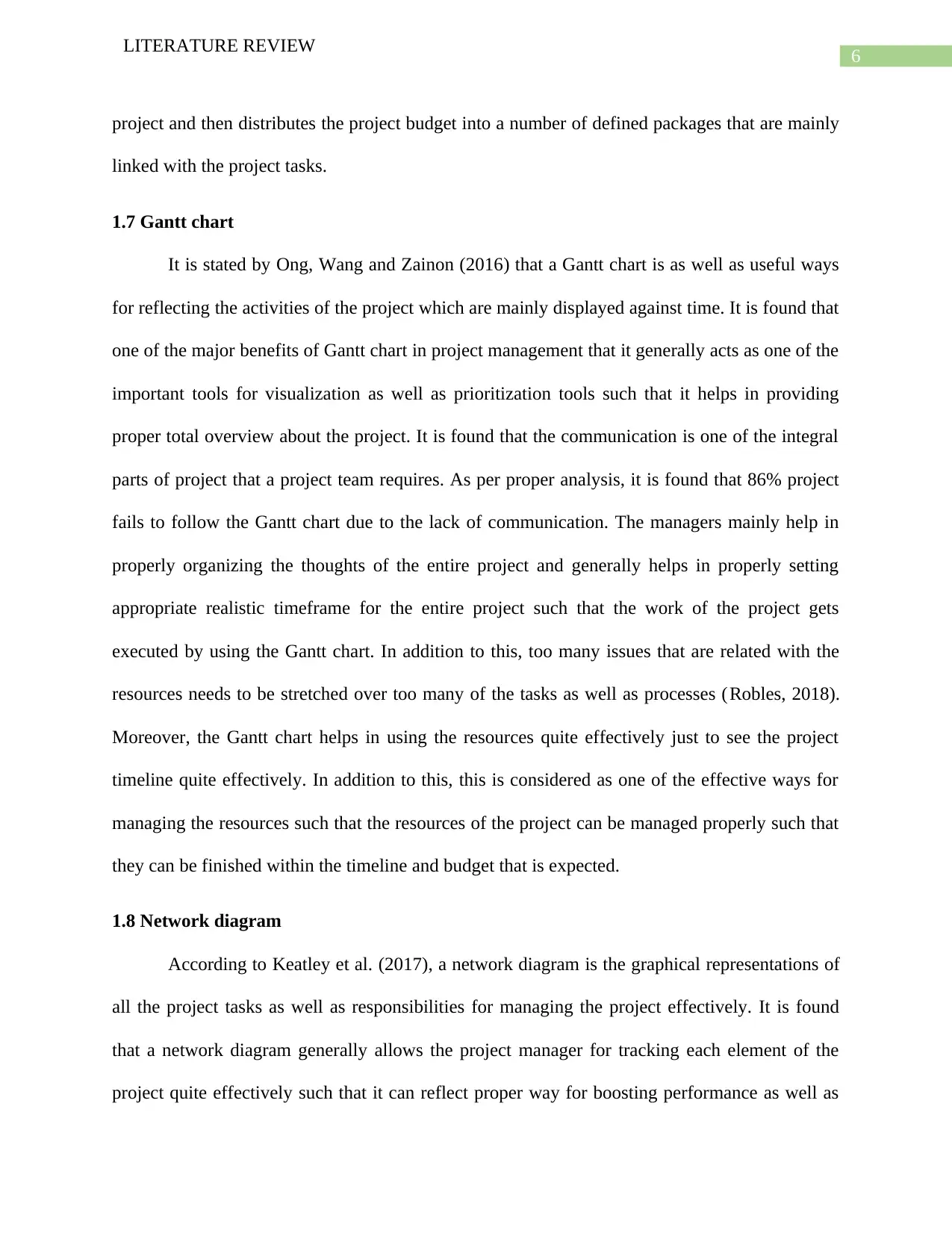
6
LITERATURE REVIEW
project and then distributes the project budget into a number of defined packages that are mainly
linked with the project tasks.
1.7 Gantt chart
It is stated by Ong, Wang and Zainon (2016) that a Gantt chart is as well as useful ways
for reflecting the activities of the project which are mainly displayed against time. It is found that
one of the major benefits of Gantt chart in project management that it generally acts as one of the
important tools for visualization as well as prioritization tools such that it helps in providing
proper total overview about the project. It is found that the communication is one of the integral
parts of project that a project team requires. As per proper analysis, it is found that 86% project
fails to follow the Gantt chart due to the lack of communication. The managers mainly help in
properly organizing the thoughts of the entire project and generally helps in properly setting
appropriate realistic timeframe for the entire project such that the work of the project gets
executed by using the Gantt chart. In addition to this, too many issues that are related with the
resources needs to be stretched over too many of the tasks as well as processes (Robles, 2018).
Moreover, the Gantt chart helps in using the resources quite effectively just to see the project
timeline quite effectively. In addition to this, this is considered as one of the effective ways for
managing the resources such that the resources of the project can be managed properly such that
they can be finished within the timeline and budget that is expected.
1.8 Network diagram
According to Keatley et al. (2017), a network diagram is the graphical representations of
all the project tasks as well as responsibilities for managing the project effectively. It is found
that a network diagram generally allows the project manager for tracking each element of the
project quite effectively such that it can reflect proper way for boosting performance as well as
LITERATURE REVIEW
project and then distributes the project budget into a number of defined packages that are mainly
linked with the project tasks.
1.7 Gantt chart
It is stated by Ong, Wang and Zainon (2016) that a Gantt chart is as well as useful ways
for reflecting the activities of the project which are mainly displayed against time. It is found that
one of the major benefits of Gantt chart in project management that it generally acts as one of the
important tools for visualization as well as prioritization tools such that it helps in providing
proper total overview about the project. It is found that the communication is one of the integral
parts of project that a project team requires. As per proper analysis, it is found that 86% project
fails to follow the Gantt chart due to the lack of communication. The managers mainly help in
properly organizing the thoughts of the entire project and generally helps in properly setting
appropriate realistic timeframe for the entire project such that the work of the project gets
executed by using the Gantt chart. In addition to this, too many issues that are related with the
resources needs to be stretched over too many of the tasks as well as processes (Robles, 2018).
Moreover, the Gantt chart helps in using the resources quite effectively just to see the project
timeline quite effectively. In addition to this, this is considered as one of the effective ways for
managing the resources such that the resources of the project can be managed properly such that
they can be finished within the timeline and budget that is expected.
1.8 Network diagram
According to Keatley et al. (2017), a network diagram is the graphical representations of
all the project tasks as well as responsibilities for managing the project effectively. It is found
that a network diagram generally allows the project manager for tracking each element of the
project quite effectively such that it can reflect proper way for boosting performance as well as
Paraphrase This Document
Need a fresh take? Get an instant paraphrase of this document with our AI Paraphraser
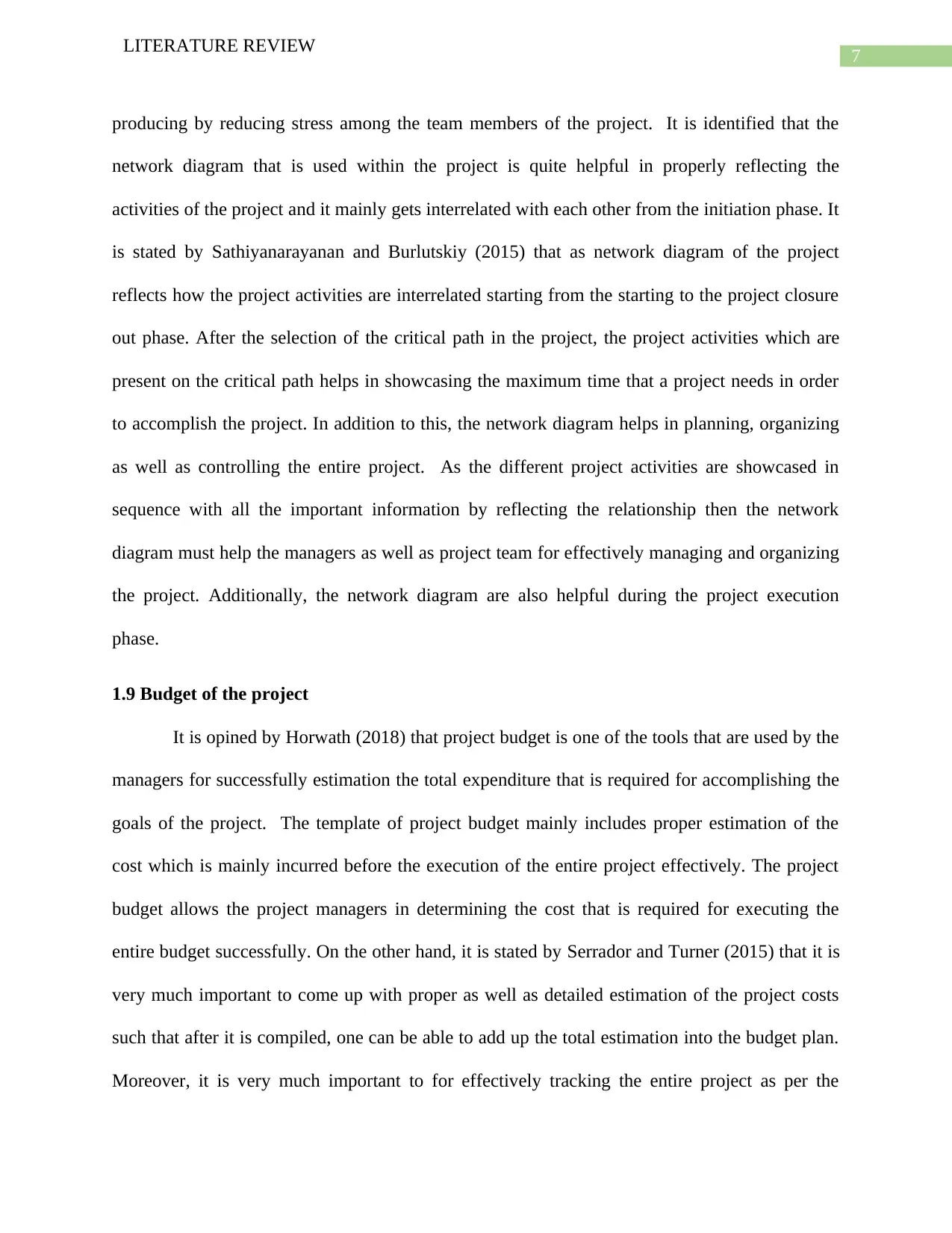
7
LITERATURE REVIEW
producing by reducing stress among the team members of the project. It is identified that the
network diagram that is used within the project is quite helpful in properly reflecting the
activities of the project and it mainly gets interrelated with each other from the initiation phase. It
is stated by Sathiyanarayanan and Burlutskiy (2015) that as network diagram of the project
reflects how the project activities are interrelated starting from the starting to the project closure
out phase. After the selection of the critical path in the project, the project activities which are
present on the critical path helps in showcasing the maximum time that a project needs in order
to accomplish the project. In addition to this, the network diagram helps in planning, organizing
as well as controlling the entire project. As the different project activities are showcased in
sequence with all the important information by reflecting the relationship then the network
diagram must help the managers as well as project team for effectively managing and organizing
the project. Additionally, the network diagram are also helpful during the project execution
phase.
1.9 Budget of the project
It is opined by Horwath (2018) that project budget is one of the tools that are used by the
managers for successfully estimation the total expenditure that is required for accomplishing the
goals of the project. The template of project budget mainly includes proper estimation of the
cost which is mainly incurred before the execution of the entire project effectively. The project
budget allows the project managers in determining the cost that is required for executing the
entire budget successfully. On the other hand, it is stated by Serrador and Turner (2015) that it is
very much important to come up with proper as well as detailed estimation of the project costs
such that after it is compiled, one can be able to add up the total estimation into the budget plan.
Moreover, it is very much important to for effectively tracking the entire project as per the
LITERATURE REVIEW
producing by reducing stress among the team members of the project. It is identified that the
network diagram that is used within the project is quite helpful in properly reflecting the
activities of the project and it mainly gets interrelated with each other from the initiation phase. It
is stated by Sathiyanarayanan and Burlutskiy (2015) that as network diagram of the project
reflects how the project activities are interrelated starting from the starting to the project closure
out phase. After the selection of the critical path in the project, the project activities which are
present on the critical path helps in showcasing the maximum time that a project needs in order
to accomplish the project. In addition to this, the network diagram helps in planning, organizing
as well as controlling the entire project. As the different project activities are showcased in
sequence with all the important information by reflecting the relationship then the network
diagram must help the managers as well as project team for effectively managing and organizing
the project. Additionally, the network diagram are also helpful during the project execution
phase.
1.9 Budget of the project
It is opined by Horwath (2018) that project budget is one of the tools that are used by the
managers for successfully estimation the total expenditure that is required for accomplishing the
goals of the project. The template of project budget mainly includes proper estimation of the
cost which is mainly incurred before the execution of the entire project effectively. The project
budget allows the project managers in determining the cost that is required for executing the
entire budget successfully. On the other hand, it is stated by Serrador and Turner (2015) that it is
very much important to come up with proper as well as detailed estimation of the project costs
such that after it is compiled, one can be able to add up the total estimation into the budget plan.
Moreover, it is very much important to for effectively tracking the entire project as per the
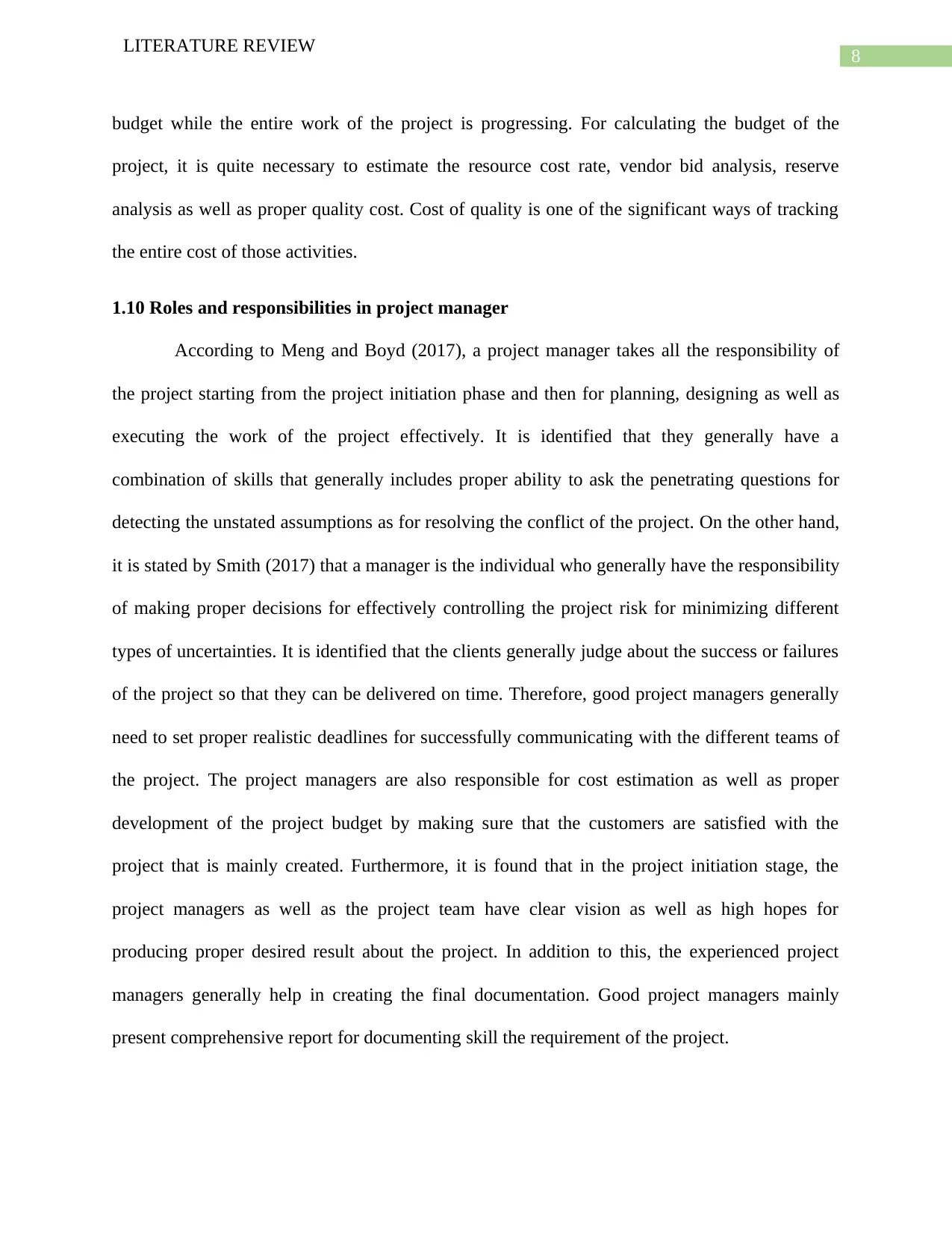
8
LITERATURE REVIEW
budget while the entire work of the project is progressing. For calculating the budget of the
project, it is quite necessary to estimate the resource cost rate, vendor bid analysis, reserve
analysis as well as proper quality cost. Cost of quality is one of the significant ways of tracking
the entire cost of those activities.
1.10 Roles and responsibilities in project manager
According to Meng and Boyd (2017), a project manager takes all the responsibility of
the project starting from the project initiation phase and then for planning, designing as well as
executing the work of the project effectively. It is identified that they generally have a
combination of skills that generally includes proper ability to ask the penetrating questions for
detecting the unstated assumptions as for resolving the conflict of the project. On the other hand,
it is stated by Smith (2017) that a manager is the individual who generally have the responsibility
of making proper decisions for effectively controlling the project risk for minimizing different
types of uncertainties. It is identified that the clients generally judge about the success or failures
of the project so that they can be delivered on time. Therefore, good project managers generally
need to set proper realistic deadlines for successfully communicating with the different teams of
the project. The project managers are also responsible for cost estimation as well as proper
development of the project budget by making sure that the customers are satisfied with the
project that is mainly created. Furthermore, it is found that in the project initiation stage, the
project managers as well as the project team have clear vision as well as high hopes for
producing proper desired result about the project. In addition to this, the experienced project
managers generally help in creating the final documentation. Good project managers mainly
present comprehensive report for documenting skill the requirement of the project.
LITERATURE REVIEW
budget while the entire work of the project is progressing. For calculating the budget of the
project, it is quite necessary to estimate the resource cost rate, vendor bid analysis, reserve
analysis as well as proper quality cost. Cost of quality is one of the significant ways of tracking
the entire cost of those activities.
1.10 Roles and responsibilities in project manager
According to Meng and Boyd (2017), a project manager takes all the responsibility of
the project starting from the project initiation phase and then for planning, designing as well as
executing the work of the project effectively. It is identified that they generally have a
combination of skills that generally includes proper ability to ask the penetrating questions for
detecting the unstated assumptions as for resolving the conflict of the project. On the other hand,
it is stated by Smith (2017) that a manager is the individual who generally have the responsibility
of making proper decisions for effectively controlling the project risk for minimizing different
types of uncertainties. It is identified that the clients generally judge about the success or failures
of the project so that they can be delivered on time. Therefore, good project managers generally
need to set proper realistic deadlines for successfully communicating with the different teams of
the project. The project managers are also responsible for cost estimation as well as proper
development of the project budget by making sure that the customers are satisfied with the
project that is mainly created. Furthermore, it is found that in the project initiation stage, the
project managers as well as the project team have clear vision as well as high hopes for
producing proper desired result about the project. In addition to this, the experienced project
managers generally help in creating the final documentation. Good project managers mainly
present comprehensive report for documenting skill the requirement of the project.
⊘ This is a preview!⊘
Do you want full access?
Subscribe today to unlock all pages.

Trusted by 1+ million students worldwide
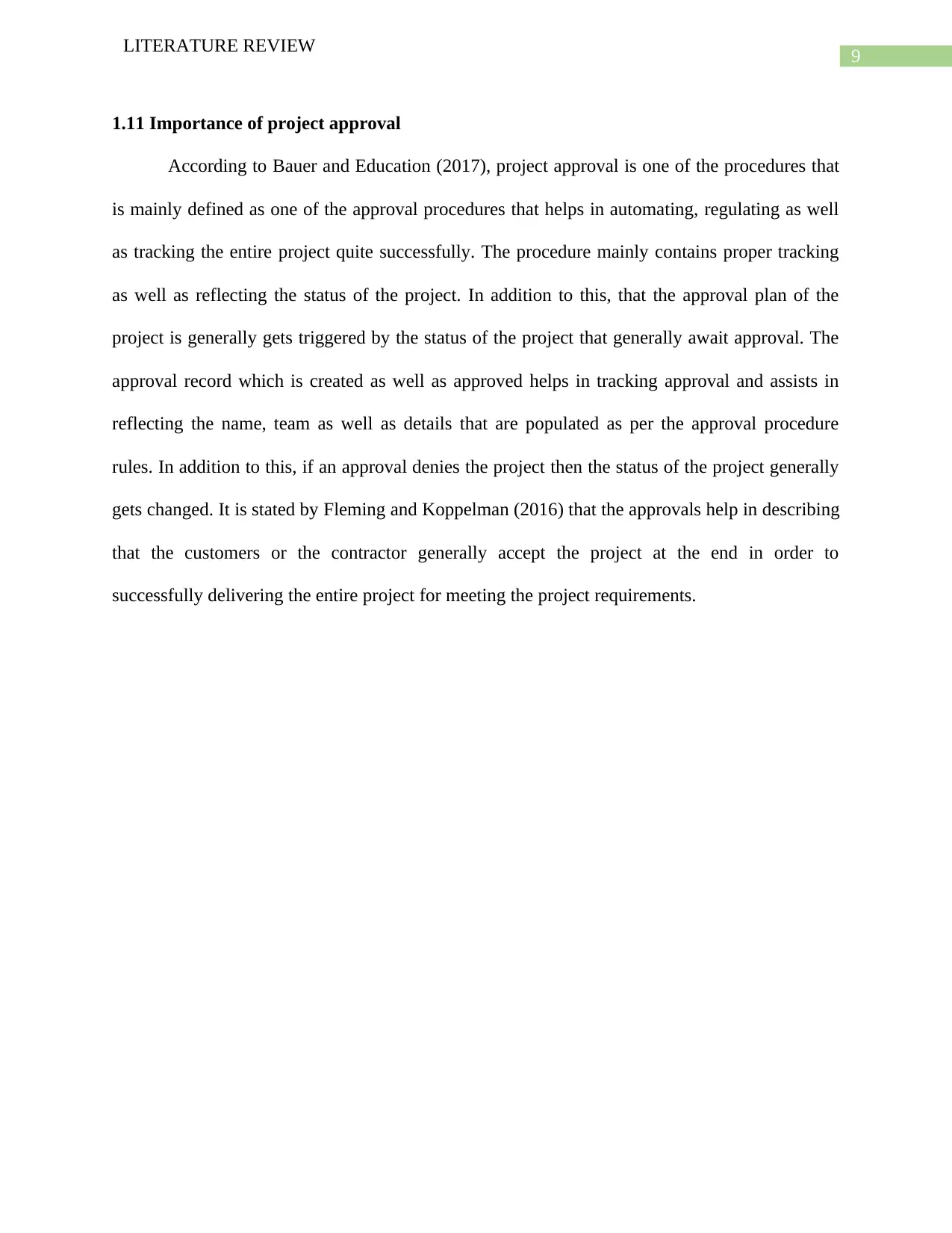
9
LITERATURE REVIEW
1.11 Importance of project approval
According to Bauer and Education (2017), project approval is one of the procedures that
is mainly defined as one of the approval procedures that helps in automating, regulating as well
as tracking the entire project quite successfully. The procedure mainly contains proper tracking
as well as reflecting the status of the project. In addition to this, that the approval plan of the
project is generally gets triggered by the status of the project that generally await approval. The
approval record which is created as well as approved helps in tracking approval and assists in
reflecting the name, team as well as details that are populated as per the approval procedure
rules. In addition to this, if an approval denies the project then the status of the project generally
gets changed. It is stated by Fleming and Koppelman (2016) that the approvals help in describing
that the customers or the contractor generally accept the project at the end in order to
successfully delivering the entire project for meeting the project requirements.
LITERATURE REVIEW
1.11 Importance of project approval
According to Bauer and Education (2017), project approval is one of the procedures that
is mainly defined as one of the approval procedures that helps in automating, regulating as well
as tracking the entire project quite successfully. The procedure mainly contains proper tracking
as well as reflecting the status of the project. In addition to this, that the approval plan of the
project is generally gets triggered by the status of the project that generally await approval. The
approval record which is created as well as approved helps in tracking approval and assists in
reflecting the name, team as well as details that are populated as per the approval procedure
rules. In addition to this, if an approval denies the project then the status of the project generally
gets changed. It is stated by Fleming and Koppelman (2016) that the approvals help in describing
that the customers or the contractor generally accept the project at the end in order to
successfully delivering the entire project for meeting the project requirements.
Paraphrase This Document
Need a fresh take? Get an instant paraphrase of this document with our AI Paraphraser
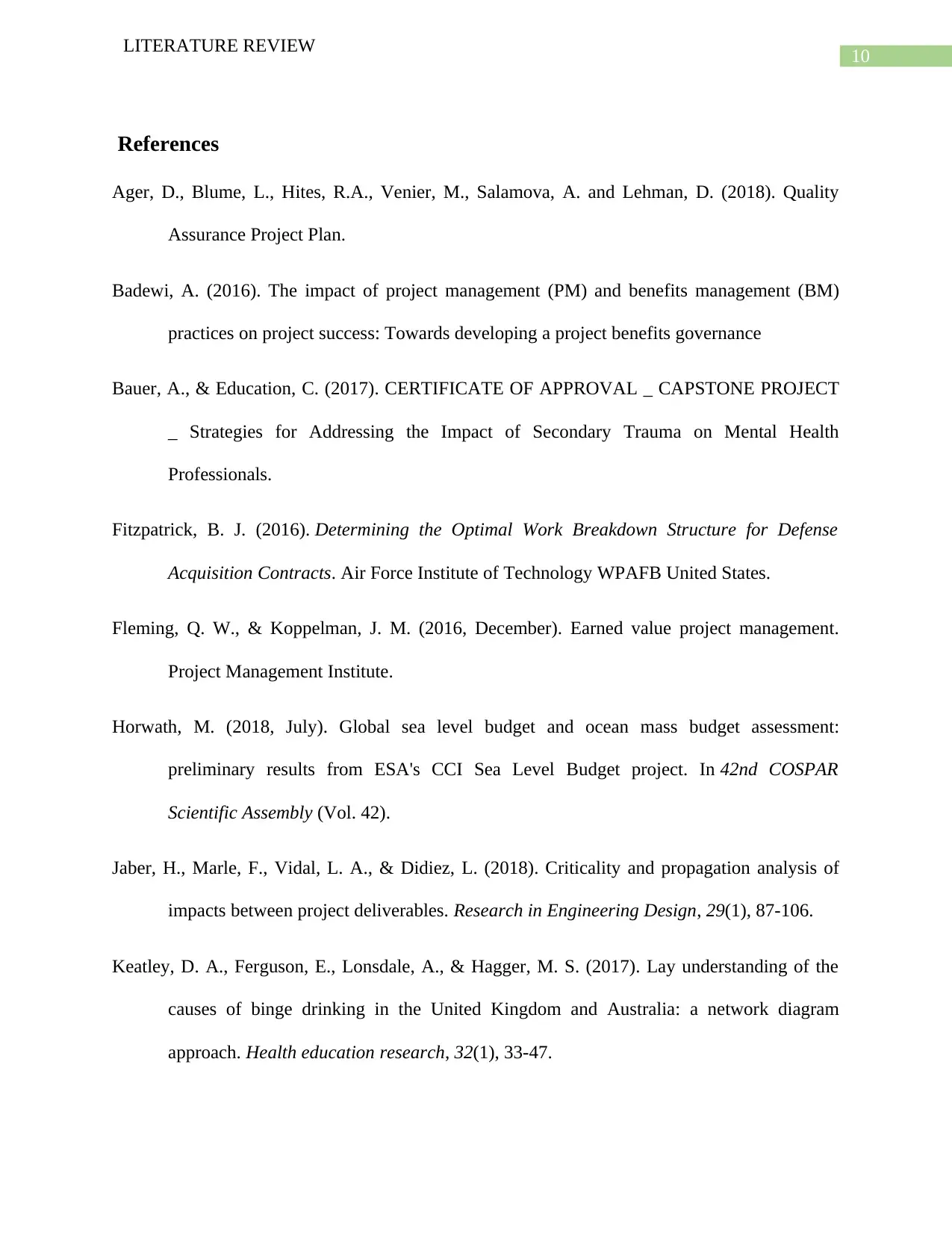
10
LITERATURE REVIEW
References
Ager, D., Blume, L., Hites, R.A., Venier, M., Salamova, A. and Lehman, D. (2018). Quality
Assurance Project Plan.
Badewi, A. (2016). The impact of project management (PM) and benefits management (BM)
practices on project success: Towards developing a project benefits governance
Bauer, A., & Education, C. (2017). CERTIFICATE OF APPROVAL _ CAPSTONE PROJECT
_ Strategies for Addressing the Impact of Secondary Trauma on Mental Health
Professionals.
Fitzpatrick, B. J. (2016). Determining the Optimal Work Breakdown Structure for Defense
Acquisition Contracts. Air Force Institute of Technology WPAFB United States.
Fleming, Q. W., & Koppelman, J. M. (2016, December). Earned value project management.
Project Management Institute.
Horwath, M. (2018, July). Global sea level budget and ocean mass budget assessment:
preliminary results from ESA's CCI Sea Level Budget project. In 42nd COSPAR
Scientific Assembly (Vol. 42).
Jaber, H., Marle, F., Vidal, L. A., & Didiez, L. (2018). Criticality and propagation analysis of
impacts between project deliverables. Research in Engineering Design, 29(1), 87-106.
Keatley, D. A., Ferguson, E., Lonsdale, A., & Hagger, M. S. (2017). Lay understanding of the
causes of binge drinking in the United Kingdom and Australia: a network diagram
approach. Health education research, 32(1), 33-47.
LITERATURE REVIEW
References
Ager, D., Blume, L., Hites, R.A., Venier, M., Salamova, A. and Lehman, D. (2018). Quality
Assurance Project Plan.
Badewi, A. (2016). The impact of project management (PM) and benefits management (BM)
practices on project success: Towards developing a project benefits governance
Bauer, A., & Education, C. (2017). CERTIFICATE OF APPROVAL _ CAPSTONE PROJECT
_ Strategies for Addressing the Impact of Secondary Trauma on Mental Health
Professionals.
Fitzpatrick, B. J. (2016). Determining the Optimal Work Breakdown Structure for Defense
Acquisition Contracts. Air Force Institute of Technology WPAFB United States.
Fleming, Q. W., & Koppelman, J. M. (2016, December). Earned value project management.
Project Management Institute.
Horwath, M. (2018, July). Global sea level budget and ocean mass budget assessment:
preliminary results from ESA's CCI Sea Level Budget project. In 42nd COSPAR
Scientific Assembly (Vol. 42).
Jaber, H., Marle, F., Vidal, L. A., & Didiez, L. (2018). Criticality and propagation analysis of
impacts between project deliverables. Research in Engineering Design, 29(1), 87-106.
Keatley, D. A., Ferguson, E., Lonsdale, A., & Hagger, M. S. (2017). Lay understanding of the
causes of binge drinking in the United Kingdom and Australia: a network diagram
approach. Health education research, 32(1), 33-47.
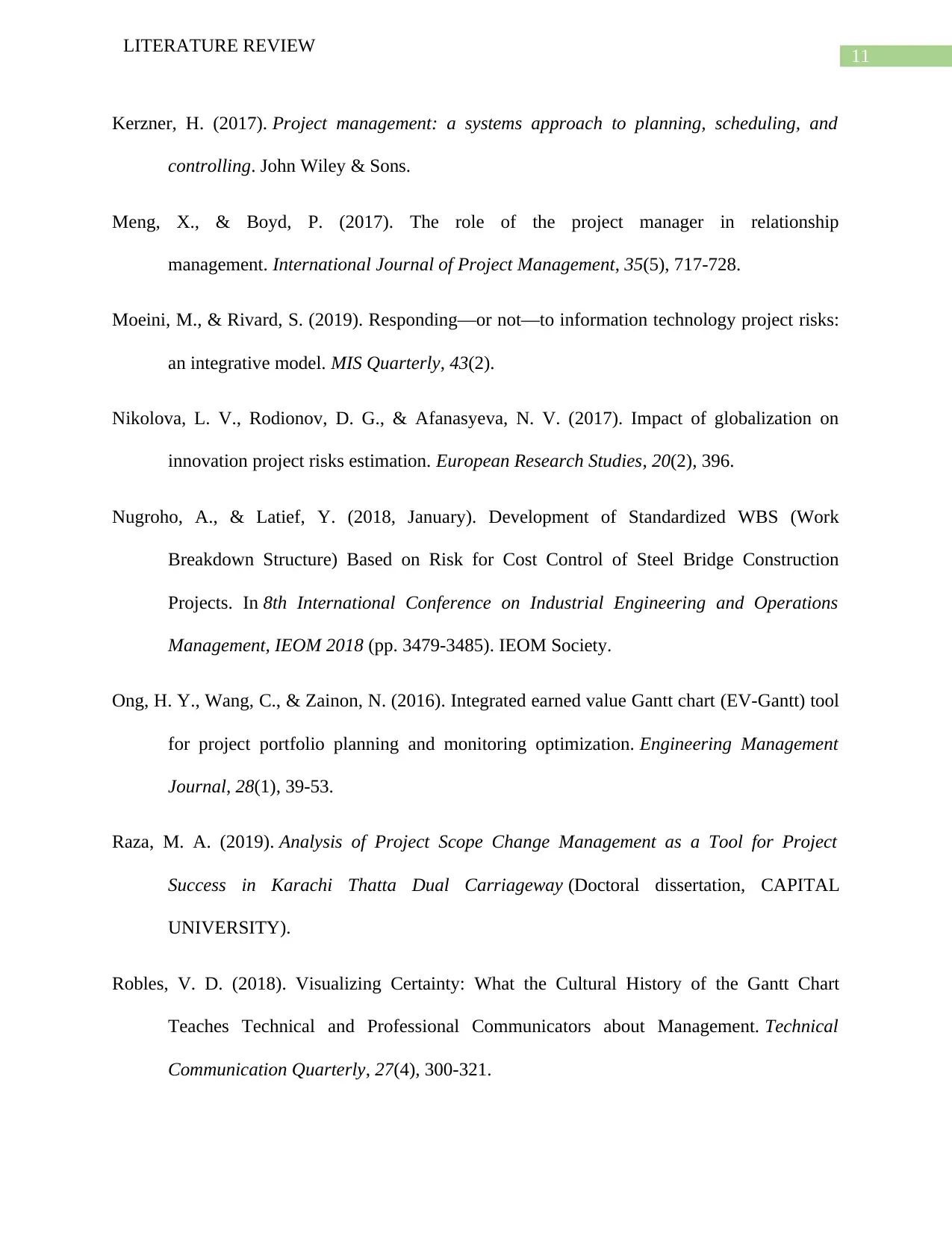
11
LITERATURE REVIEW
Kerzner, H. (2017). Project management: a systems approach to planning, scheduling, and
controlling. John Wiley & Sons.
Meng, X., & Boyd, P. (2017). The role of the project manager in relationship
management. International Journal of Project Management, 35(5), 717-728.
Moeini, M., & Rivard, S. (2019). Responding—or not—to information technology project risks:
an integrative model. MIS Quarterly, 43(2).
Nikolova, L. V., Rodionov, D. G., & Afanasyeva, N. V. (2017). Impact of globalization on
innovation project risks estimation. European Research Studies, 20(2), 396.
Nugroho, A., & Latief, Y. (2018, January). Development of Standardized WBS (Work
Breakdown Structure) Based on Risk for Cost Control of Steel Bridge Construction
Projects. In 8th International Conference on Industrial Engineering and Operations
Management, IEOM 2018 (pp. 3479-3485). IEOM Society.
Ong, H. Y., Wang, C., & Zainon, N. (2016). Integrated earned value Gantt chart (EV-Gantt) tool
for project portfolio planning and monitoring optimization. Engineering Management
Journal, 28(1), 39-53.
Raza, M. A. (2019). Analysis of Project Scope Change Management as a Tool for Project
Success in Karachi Thatta Dual Carriageway (Doctoral dissertation, CAPITAL
UNIVERSITY).
Robles, V. D. (2018). Visualizing Certainty: What the Cultural History of the Gantt Chart
Teaches Technical and Professional Communicators about Management. Technical
Communication Quarterly, 27(4), 300-321.
LITERATURE REVIEW
Kerzner, H. (2017). Project management: a systems approach to planning, scheduling, and
controlling. John Wiley & Sons.
Meng, X., & Boyd, P. (2017). The role of the project manager in relationship
management. International Journal of Project Management, 35(5), 717-728.
Moeini, M., & Rivard, S. (2019). Responding—or not—to information technology project risks:
an integrative model. MIS Quarterly, 43(2).
Nikolova, L. V., Rodionov, D. G., & Afanasyeva, N. V. (2017). Impact of globalization on
innovation project risks estimation. European Research Studies, 20(2), 396.
Nugroho, A., & Latief, Y. (2018, January). Development of Standardized WBS (Work
Breakdown Structure) Based on Risk for Cost Control of Steel Bridge Construction
Projects. In 8th International Conference on Industrial Engineering and Operations
Management, IEOM 2018 (pp. 3479-3485). IEOM Society.
Ong, H. Y., Wang, C., & Zainon, N. (2016). Integrated earned value Gantt chart (EV-Gantt) tool
for project portfolio planning and monitoring optimization. Engineering Management
Journal, 28(1), 39-53.
Raza, M. A. (2019). Analysis of Project Scope Change Management as a Tool for Project
Success in Karachi Thatta Dual Carriageway (Doctoral dissertation, CAPITAL
UNIVERSITY).
Robles, V. D. (2018). Visualizing Certainty: What the Cultural History of the Gantt Chart
Teaches Technical and Professional Communicators about Management. Technical
Communication Quarterly, 27(4), 300-321.
⊘ This is a preview!⊘
Do you want full access?
Subscribe today to unlock all pages.

Trusted by 1+ million students worldwide
1 out of 13
Related Documents
Your All-in-One AI-Powered Toolkit for Academic Success.
+13062052269
info@desklib.com
Available 24*7 on WhatsApp / Email
![[object Object]](/_next/static/media/star-bottom.7253800d.svg)
Unlock your academic potential
Copyright © 2020–2025 A2Z Services. All Rights Reserved. Developed and managed by ZUCOL.





